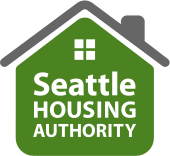SEATTLE—October 26, 2007—You get a sense, in talking with Samuel A. Pierce, that he’s not an easy man to say “no” to.
It’s not that Pierce, the Employment Coordinator for Seattle Housing Authority’s Section 3 program, is fierce-looking or loud. On the contrary: He’s pleasant-looking and quite soft-spoken.
But if you were a contractor working on a Seattle Housing Authority project and Pierce were to approach you about hiring low-income SHA residents, you’d be looking for ways to accommodate his request.
If you were in charge of a union’s apprenticeship program and he asked you to consider certain residents for your program, you’d do your best to take those residents in for training and placement.
And if you were a low-income resident eligible for the Section 3 program, you’d find it nearly impossible to turn Pierce down when he offered to create a résumé for you, point you to programs that provide training and education, and let you know that all you have to do is give the word and he’ll do his best to find you a good job, a job with benefits, a job with a future.
All because you’d find him relentlessly pleasant—with an emphasis on “relentless.”
Pierce’s days are spent in outreach: in meeting with contractors and union officials, in setting up and attending job fairs, in meeting and encouraging residents and potential employers alike.
He meets every day in his High Point office with Seattle Housing Authority residents and other prospective clients. He meets every month with an 11-member advisory committee that oversees both SHA’s progress toward Section 3 goals and contractors’ compliance with Section 3 requirements.
“My goal is to help eliminate barriers in the building trades,” Pierce said. “I really want to help people in the community be successful.”
Section 3—the name for a HUD program that dates to 1968—provides the legal basis for SHA to provide or find jobs for residents and award contracts to businesses in construction projects that receive certain types of HUD financial assistance. These projects are mainly the HOPE VI communities of High Point, NewHolly and Rainier Vista.
In bid documents on these projects, and in its construction contracts, SHA requires contractors and their subcontractors to agree to hire people who live in or near HOPE VI communities. More particularly, SHA requires that 30 percent of new hires, that is, workers outside a contractor’s experienced core work crew, go to Section 3-eligible residents. (The agency actually wants to see 100 percent of Section 3 contractors’ new hires going to its qualified residents and other low-income people.)
Of these new hires, 15 percent must be apprentices—a figure that’s much higher, Pierce said, than on most building projects. For its part, SHA identifies low-income people it houses in HOPE VI communities and others, including people who receive assistance under the Housing Choice Voucher Program (Section 8).
After Pierce prepares a résumé for a client, he tries to get him or her hired. His chief mission is placing people in construction-industry jobs, but together with his colleagues at The Job Connection, his workplace at SHA, he also places clients in production, warehousing, social services, administrative and secretarial jobs.
Under federal rules, Pierce is required to give first priority, in helping clients find jobs with contractors, to low-income residents of HOPE VI communities at which construction is planned or taking place. Next he looks to any resident of any SHA building or program, including Section 8.
Then he turns to people in “Youth Build,” a HUD program administered by King County that trains people for jobs in the construction and building industries. He then reaches out to low-income residents who live near HOPE VI communities, which in practical terms means people who live in adjacent ZIP codes.
Typically Pierce develops a list of eligible Section 3 prospects for submission to contractors and subcontractors. Among those contractors are Tri State Construction, W. G. Clark, 3 Kings Environmental, Inc., Absher Construction and Turner Construction.
“I’ll send the list to the contractors, and a person on the list will interview with the contractor,” Pierce said. “If all is O.K., he or she gets hired. If not, we send another person. If no one is qualified, then the contractor or subcontractor can hire out.”
Contractors are often looking for experienced workers, for journeymen, but, Pierce said, there aren’t usually too many out-of-work journeymen in the population of residents he serves. Still, he does identify some, and he sends them and a steady stream of apprenticeship candidates the contractors’ way.
If a contractor shows interest in a prospective apprentice, the contractor endorses the candidate, who then spends a week in Kingston, Wash., in a training program before reporting to the job site. Most apprentices learn earthmoving and similar skills, or carpentry.
Michael Woo, a community organizer with a good deal of experience in construction who sits on the Section 3 advisory committee, said recently that Section 3 “aims at trying to provide benefit to all members of the community. It’s an important tool to help community residents reach some level of success in transforming their lives. SHA has shown a strong commitment to the Section 3 program. Without that commitment, the program would go nowhere.”
Pierce meets often with his peers and colleagues at social service agencies and at the Seattle Vocational Institute. As a former employee of Workforce and of the Seattle Youth Employment program with a long experience of delivery social services, he speaks their language.
Another member of the advisory committee, Grover Johnson, of the Northwest Regional Organizing Coalition, said recently that what SHA is doing for people under its Section 3 program “should be implemented by other agencies throughout the city and the county. SHA is seeing to it that people get jobs that come with health insurance, good jobs, and I hope that this will be a model for other agencies.”
